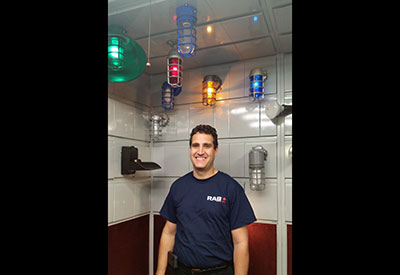Joel Spira: Remembering an Industry Giant

November 13, 2017
To those in the lighting industry the name Joel Spira is one that most are familiar with, and if not his name then the company he founded, Lutron Electronics. We all read in 2015 about his sad passing at the age of 88, but a long well-lived life it was. Here we pay tribute to that life by profiling Joel and the contributions he made to the lighting industry, including his achievements that brought dimming abilities into countless homes.
Joel Spira was born on March 1, 1927 in New York City. At 18 he began studying physics at Purdue University, but put his studies on hold to enlist in the Navy during World War II. While in the Navy Joel worked on special projects that granted him access to electronics and the design of complex electrical systems.
After the war Joel returned to Purdue and obtained his degree in physics, after which he worked on a wide range of defence projects including designing guided missiles. He spent a decade working in the weapons sector, which in the end was responsible for the idea that would soon change home lighting. While working on a fuse mechanism for atomic bombs, he got the idea for a compact light dimmer because he saw how a small semiconductor had the ability to control large amounts of energy.
At the time homebuilding was booming in the U.S., and Joel had the idea that if he developed a low-cost dimmer that could control standard incandescent bulbs there was a readymade market for them. Light dimming was not new, but was at the time limited in its use to locations such as theatres. Dimming involved a rheostat that absorbed electric energy and converted it to heat. However, he soon learned of the invention of a solid-state semiconductor with the ability to interrupt electricity that forced it to pulse instead of flow.
After a significant amount of testing with his wife Ruth in the spare room of their apartment on the Upper West Side of Manhattan, they found just the right balance of bright to dim they were aiming for. And so, the Spiras decided to launch their new business. In 1961 they moved to Emmaus, Pennsylvania, where Ruth’s father gave them 1,000 square feet of space. There they founded Lutron, and were the first to mass-market dimmer switches. The initial marketing for the dimmer was based not on its energy saving abilities but on the effect it could create. The rotary dimmer allowed one to “dial romance” and create mood lighting.
Beyond being the first to develop a rotary dimmer, Joel Spira took dimming further by being the first to invent a sliding dimmer with the Nova model. Due to Joel’s obsessive attention to detail, the Nova was one of the first true white switches that also hid the screws for seamless finish. Further, the sliding dimmer also worked in a way that was pleasing to the eye: when the slider was at halfway lighting in the room was dimmed by 50% based on human perception.
Next came the ability to dim fluorescents, and controls for scene setting and then the advancements we have seen in more recent years that have included LEDs and IoT.
There are a number of stories about Joel Spira, and no wonder after so many years in the business. First, he was known for being extremely humble and down to earth about his success, preferring to continue working, which he did for over five decades in the lighting industry. And, he treated his workers like family. There are stories of his daughter and the children of other workers playing hide and seek in the warehouse on weekends. Joel truly was a company man and welcomed his workers and their families into the fold. Further, there are accounts of the time Joel took to meet and talk with numerous industry professionals and up and comers, whose accounts describe a kind and straightforward individual who would bring his family to business engagements.
With Lutron’s success Spira continued to think about the future of lighting and its ultimate affect on individuals and his business model. He realized that lighting was a major portion of home energy usage and that promoting energy savings through dimming, and expanding dimming to multiple areas of the house, would address a growing consumer concern, even if he himself wasn’t totally sold on the idea in the 1970s.
Following the trend in energy savings, Lutron has expanded its line over the years and has continued to lead in the control of dimmers, sensors and automated shades. The company has also transcended generations of the Spira family. His daughter Susan is now co-chairman and co-CEO, and his grandson works for the company.
Over the years the company has been presented the opportunity to undertake significant projects, including the Statue of Liberty, Empire State Building, Windsor Castle in the United Kingdom, and the Bank of China headquarters in Beijing. Joel Spira himself also donated his dimmer artefact, the 1964 version of the original “Capri” rotary switch, as part of the Electricity Collection project for Museum of Natural History.
In April of 2015 Joel Spira passed away of natural causes. His company however carries on with his mission to continue pushing the boundaries of lighting control.
Sources
Digital Lighting: http://digital.lighting.co.uk/lighting/issue_03_june_2017?pg=83#pg83
The Morning Call: http://www.mcall.com/news/local/southernlehigh/mc-lutron-joel-spira-death-20150408-story.html
http://www.mcall.com/mc-lutron-founder-joel-spira-bio-20150408-story.html
National Geographic: https://news.nationalgeographic.com/news/2010/06/100604-energy-electric-light-dimmer-inventor/
Image source: http://www.mcall.com/news/local/southernlehigh/mc-lutron-joel-spira-death-20150408-story.html













